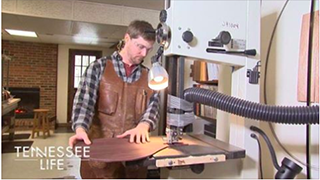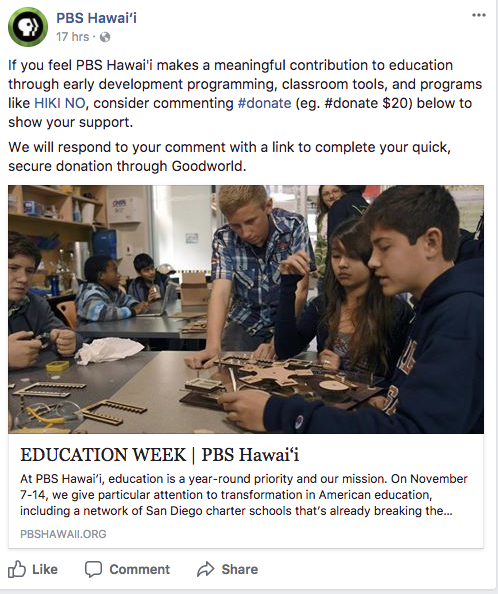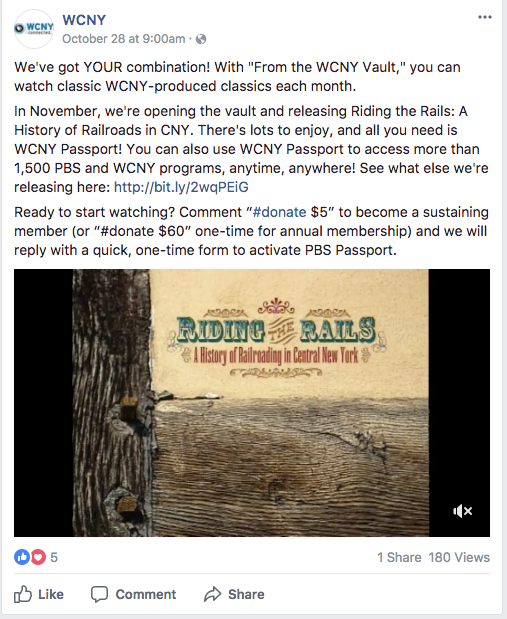Stations Experiment with Local Content During Passport #donate Pilot

Stations Experiment with Local Content During Passport #donate Pilot
In October 2017, PBS Development Services partnered with fourteen member stations in a fifteen-day pilot to test instant Passport access from donations made using Goodworld’s #donate (e.g. #donate $20) technology on Facebook. The October pilot was the second pilot in the #donate series. Stations created Facebook posts asking followers to “#donate” in the post thread, using readily-available national Passport assets and messaging for popular Passport programs.
Unlike the March pilot which tested #donate on Twitter and Facebook, stations were asked instead to focus their efforts on Facebook due to the social network’s content-friendly user experience. Stations reported twice as much Facebook post engagement than the March pilot, which showcased on-air pledge shows rather than programs available for immediate Passport streaming. A number of stations including PBS Hawaii, Montana PBS, East Tennessee PBS, and WCNY, used this opportunity to showcase their local Passport content, resulting in increased engagement during the pilot.
Highlighting local content pays off for PBS Hawai’i in #donate pilot

When PBS Hawaiʻi participated in the first #donate pilot in 2017, it performed best among those 29 stations. “So we were thrilled to be a part of this one again,” says Liberty Peralta, the station’s vice president of communications.
She and her team used many of the assets provided by PBS, but quickly determined that demonstrating the value of local content would be the key to engaging its viewers in the campaign. “We know that when we localize our content, it tends to resonate more with people on social media,” says Peralta.
First, her team created a pre-produced explainer video about #donate. “[That kind of video] did well for us last time, because it is a new concept for people to grasp,” she says. “It helps by talking it through with people and getting them familiar with the steps.”
PBS Hawai’i’s social media then focused on promoting programs like HIKI NO, a statewide digital learning initiative and student news program, as well as the documentary Most Likely to Succeed, which the station was chosen to air exclusively among PBS member stations. “We used that as an example, to say ‘Hey, here’s a cool thing that we did. If you believe in stuff like this, and feel compelled to support us, please use #donate,’” says Peralta.
During the most recent pilot, the local content led to the station receiving 11 pledged donations. Two of them were completed successfully to raise a total of $65 over the pilot period. (In the first pilot period, PBS Hawai’i had 17 pledged donations, 7 completed donations and $175 raised.) “The most challenging thing was getting past the initial steps involved for interested people to complete the donation after they used the hashtag,” reports Peralta. “That’s why a lot of our donations were incomplete.”
Despite that, she feels the campaign is always beneficial, because people need time and familiarity to adapt to new technology. “By planting that seed and talking about #donate, people start to understand the concept and feel okay enough with using it,” she says. “Anything that involves a new technology and trying to get people to part with their money is going to have built-in challenges. We’re looking at this from a long-term perspective.”
With WCNY, local content reaps more engagement on Facebook
Participating in the #donate pilot, WCNY in Syracuse experimented with several kinds of videos promoting the programming available through Passport. Some posts touted the overall benefits of Passport and pointed toward nationwide programming. Others took a much more specific, local programming focus—and those posts tended to have more engagement.
“The engagement was not as much as a paid post, obviously, but according to our numbers the local content had more value for our fans,” says Haley Dubnoff, WCNY’s director of marketing, communications and creative services. “The local content probably is a good way to hook people, to show them what’s locally produced and available. If they’re interested, then they can poke around [in Passport] and see what else PBS has to offer.”

As an example, a late-October video post on Facebook highlighted Riding the Rails: A History of Railroads in CNY. “With ‘From the WCNY Vault,’ you can watch classic WCNY-produced classics each month,” explained the post. “There’s lots to enjoy, and all you need is WCNY Passport. You can also use WCNY Passport to access more than 1,500 PBS and WCNY programs, anytime, anywhere!”
That post reached 776 people and gathered 212 views. A week later, another Riding the Rails post reached a total of 316 people and had 107 views. More general #donate posts tended to result in a much smaller reach in the low triple digits.
Regardless, the #donate campaign didn’t result in any transactions for WCNY. Dubnoff speculates that confusion about the process or a lack of familiarity with goodworld.me—the payments pathway behind #donate—might have played a role. “People might wonder why there’s so many different companies involved with it rather than just the PBS station,” she says. “You’re on Facebook, then the station, then there’s Goodworld.” That complexity might raise unnecessary suspicion among those who are used to a more streamlined process.
Regardless, Dubnoff believes in the value of pilot programs like this one. “We’re always happy to participate and see how it can benefit us and other stations,” she explains. “We may not have seen any transactions, but as far as engagements and promoting Passport, that’s a good thing to do—even to people who already are members. That way, they know what’s available.”]
Local promotions “a huge win” for East Tennessee PBS

As a participant in the previous #donate pilot in 2017, East Tennessee PBS did not receive any actual donations using the technology. That wasn’t the case this fall. “For this one, we got two or three [donations], which we saw as a huge win,” says Kate Spears, the member station’s social media and events manager.
“We tried to take the copy PBS provided and weave it in with our local content,” she says. One such focus was Tennessee Life,which shares the local stories of Tennessee residents. “It’s a really popular show, so I felt like that was a good place to start,” says Spears. “We also have those episodes available to stream online, so we tried to find a way to weave in a similar message—if you enjoy streaming this, you can stream other things through Passport.”
The station also built #donate posts around local programming like The Dr. Bob Show. Those posts had moderate success. For example, the Tennessee Life promotion reached around 500 people and had two shares. “For us, that’s pretty good,” says Spears. “We don’t spend a lot of money doing Facebook promotions, so that’s all organic reach.”
East Tennessee’s most popular post during the campaign, however, was a video promoting Antiques Roadshow on Passport. It had 300 video views and reached more than 1,000 people, with an average watch time of 10 seconds. “I feel like there’s a big misconception with local viewers about PBS,” admits Spears. “They may not fully understand how programming works.” In other words, her Facebook audience may not realize that the nationally produced Antiques Roadshow is a different category of programming than the local Tennessee Life.
The station’s Facebook audience also may not have fully understood the #donate process. Spears had several people comment with #donate and a dollar amount, but failed to finalize the transaction. “We got a bunch who did that. I went back and responded again when I saw they didn’t complete the process,” she says. “That’s how we did get the ones who did eventually give.” Spears believes they didn’t understand there were additional steps to take beyond the initial comment. “We feel like some of the text PBS provided may have been a little confusing,” she says. “I feel like there would have been a few more [donations] if they understood the process better. That’s just my constructive criticism.”
She suspects that confusion may be generational. “Our audience on Facebook mostly comes from the Baby Boomer generation,” she says. “They will call us and give us their credit card number over the phone, but were maybe not willing to do that through the #donate platform. I think people in our area are still a little skeptical of technology.”
Montana PBS uses Facebook Live to add local edge, testing from “square one”

When digital content and marketing manager Laura Dick first arrived at Montana PBS in September of 2017, she noticed the station’s social media presence was limited. “There wasn’t really any engagement being fostered on our social media,” she says. That’s why she was excited to join the #donate pilot program. “My goal with #donate was two-fold: Obviously, we wanted to promote the campaign and get people on-board with Passport. But my second goal was just to educate our followers about Passport and some of the other awesome things we have on Montana PBS,” says Dick. “There hadn’t been a ton of communication about it previously, so Facebook Live seemed kind of natural.”
Upon joining the team, Dick had immediately begun getting to know the Montana PBS audience, determining when they were most engaged online—“Early evenings between 6 and 8pm get triple the views of anything else,” she says—and what kinds of posts they would interact with. “They definitely like to see faces for sure.” Dick decided that personally appearing on a Facebook Live video would be an ideal strategy. “I just wanted to do something quick and easy that felt more natural and raw than a promotional video,” she says.
So she set up her phone in the studio. “I didn’t pull together a script or practice,” she says. “I just wanted to be open and honest about how awesome Passport is and how people can take advantage of this benefit.” The video took place right before Veterans Day, so she used the opportunity to promote Ken Burns’ Vietnam War series and a veterans’ panel hosted by Montana State University.
Dick describes her efforts as a “slow, humble approach” to digital fundraising, but the video reached 716 people and had 281 views that day. During the course of the pilot, the station received just one #donate response, but Dick says the overall engagement pleased her. “Because we’re starting from square one with our social media, letting people know there’s a person available to them and that they can communicate with is a priority,” Dick says. “Right now, I’m getting really jazzed just about likes and shares and comments. Getting one #donate was far beyond my goal for the pilot.”
In comparison, a previous, pre-produced Facebook video promoting Passport garnered 81 views and reached 412 people. Dick was happy that the Facebook Live video started conversations and got people more comfortable with interacting online with Montana PBS.
